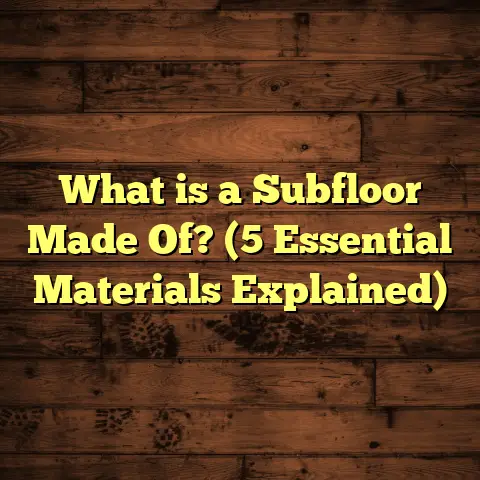What Is Floating Floor Made Of? (5 Key Materials Explained)
Floating Floors and Sustainability: Why I Care
When I first started working as a flooring contractor over a decade ago, sustainability was something few clients asked about. Most people focused on looks and price. But over the years, I’ve noticed a big change in how homeowners think about their floors. More and more, people are interested in products that are kinder to the environment. They want to reduce waste, use materials that come from responsibly managed sources, and avoid harmful chemicals in their homes.
Floating floors fit well into this mindset. Because of the way they are installed—without glue or nails—they can often be removed cleanly and reused or recycled, which is a huge plus for sustainability. Plus, many floating flooring products incorporate recycled content or renewable materials. I’ve seen firsthand how flooring choices can affect both the environment and the feel of a home.
Have you ever stopped to think about where your floor comes from? Or what will happen to it in 20 years? For me, those questions make all the difference when choosing materials.
In this article, I want to share everything I know about floating floors—the materials they’re made of, how they’re made, and why they matter from both a practical and an environmental point of view. I’ll also share some stories from my own projects to give you a real sense of what these floors are like day-to-day.
What Is a Floating Floor?
Let’s start with the basics: what is a floating floor?
Picture a floor that isn’t nailed or glued down but instead “floats” above the subfloor. That’s a floating floor in a nutshell. The planks or tiles connect to each other through tongue-and-groove or click-lock systems—kind of like puzzle pieces snapping together. They rest on top of an underlayment layer that cushions the floor and often provides moisture protection or sound dampening.
This design gives floating floors some unique advantages:
- Easier installation: You don’t need nails or glue, so installation is faster and less messy.
- Flexibility: You can lay floating floors over many existing surfaces (like vinyl or tile), saving time and money.
- Movement accommodation: The floor can expand and contract slightly with temperature or humidity changes without buckling.
- Potential for reuse: Because they aren’t permanently fixed, floating floors can sometimes be removed and reinstalled elsewhere.
Floating floors aren’t a specific material but rather a method of installation that works with various types of flooring materials. Each material offers different benefits in terms of durability, water resistance, comfort, and sustainability.
1. Laminate Flooring: The Popular Composite
What’s Laminate Made Of?
Laminate flooring is by far one of the most popular types of floating floors I install. It’s affordable, durable, and available in tons of styles that mimic hardwood, stone, or tile.
The secret behind laminate floors lies in their layered construction:
- Wear Layer: This top layer is a clear, tough coating made from melamine resin that protects the floor against scratches, stains, and fading. It’s what keeps your floor looking fresh even after years of use.
- Design Layer: Just beneath the wear layer is a high-resolution photo-realistic image printed on paper. This gives laminate its look—whether it’s oak wood grain or slate tile.
- Core Layer: Typically made from high-density fiberboard (HDF) or medium-density fiberboard (MDF). This is the thickest part that gives strength and stability.
- Backing Layer: A balancing layer that prevents moisture absorption from below and adds dimensional stability.
Manufacturing Process
The manufacturing process for laminate flooring is fascinating because it involves combining multiple technologies:
- Fiberboard Production: Wood fibers (often from recycled wood waste) are blended with resin binders and compressed under high heat and pressure to form dense fiberboard sheets.
- Printing: The decorative image is created using digital printing technology to achieve realistic patterns and colors.
- Impregnation: The printed design paper is saturated with melamine resin to make it durable.
- Layer Assembly: The core layer is sandwiched between the impregnated design paper on top and the backing layer beneath. These layers go into a high-pressure laminating press.
- Cutting & Profiling: Once pressed into sheets, the laminate boards are cut to size and machined with tongue-and-groove or click-lock edges for easy installation.
Technical Insights
Laminate flooring thickness varies, usually between 6mm to 12mm. Here’s what matters technically:
- Abrasion Class (AC) Rating: A standard measure of durability based on how much wear the surface can handle before showing signs of damage.
- AC1: Light residential use (bedrooms)
- AC2: Moderate residential use (living rooms)
- AC3: Heavy residential/light commercial use (kitchens, offices)
- AC4: Heavy commercial use (shops)
- AC5: Very heavy commercial use
Most laminate floors you’ll encounter for homes fall between AC3 and AC4.
- Thermal Resistance (R-value): Laminate floors offer insulation value typically around 0.1 to 0.15 per inch thickness, which helps improve energy efficiency slightly.
- Water Resistance: Standard laminate isn’t waterproof but newer products come with water-resistant cores for kitchens or basements.
Sustainability Considerations
Laminate flooring can be made partly from recycled wood fibers, reducing demand for virgin timber. Many manufacturers now use low-VOC adhesives and formaldehyde-free resins to improve indoor air quality.
However, laminate isn’t easily recyclable at end-of-life because of its composite structure. This means disposal can create landfill waste unless specialized recycling programs exist nearby.
My Experience Installing Laminate Floors
One project I recall vividly involved installing laminate in a home with two energetic kids and two large dogs. The family wanted something affordable but scratch-resistant and easy to clean.
The melamine wear layer really came through. After two years, the floor still looked great despite rough use—something solid hardwood might have struggled with.
Plus, installation was quick because of the floating design—I was able to finish two rooms in less than a day.
2. Vinyl Plank Flooring: Versatile and Waterproof
Composition
Vinyl plank flooring has grown in popularity because it combines style with waterproof durability—a rare combo that appeals to many homeowners.
Vinyl plank floating floors typically consist of:
- Wear Layer: A clear coat made from polyurethane or urethane infused with aluminum oxide for scratch resistance.
- Vinyl Layer: Printed vinyl film that replicates wood grain or stone textures.
- Core Layer: This varies:
- WPC (Wood Plastic Composite): A blend of wood flour and plastic resin.
- SPC (Stone Plastic Composite): Contains limestone powder mixed with plastic for added strength and rigidity.
- Backing Layer: Provides dimensional stability and moisture barrier.
How Vinyl Planks Are Made
The manufacturing process involves extrusion technology:
- Raw materials such as PVC resin, plasticizers, stabilizers, and pigments are mixed.
- The mixture is heated until molten then extruded through molds forming sheets or planks.
- Decorative films are laminated on top using heat and pressure.
- A durable wear layer is applied via coating methods like UV curing.
- Planks are cut to size and precision-machined for click-lock edges facilitating floating installation.
Technical Features
Vinyl plank thickness ranges from 4mm to 8mm generally; thicker planks offer better sound absorption and comfort underfoot.
- Waterproof: Vinyl plank floors with WPC or SPC cores are fully waterproof—ideal for bathrooms, basements, or kitchens.
- Fire Resistance: Many meet ASTM E648 Class 1 fire safety standards required in commercial buildings.
- Soundproofing: When installed over cushioned underlayment, vinyl planks reduce impact noise effectively.
Why Vinyl Works for Certain Spaces
I once installed vinyl plank flooring in a family basement that had moisture problems in summer months due to high humidity. The waterproof nature of SPC cores prevented swelling or warping like we’d seen before with hardwood in that space.
Clients appreciated not only the durability but also how realistic the wood-look finishes appeared—even up close it was hard to tell it wasn’t real wood.
Environmental Considerations
PVC production involves chemicals that raise environmental concerns during manufacture and disposal.
Some brands now offer phthalate-free vinyl options with recycled content or take-back programs for old flooring removal—steps I always recommend if sustainability matters to you.
3. Engineered Hardwood: A Hybrid Beauty
What’s Underneath the Surface?
Engineered hardwood combines the best qualities of solid hardwood with enhanced stability thanks to its layered construction:
- Top Layer (Veneer): A thin slice of real hardwood species (oak, maple, walnut) about 2-6mm thick.
- Core Layers: Multiple plywood or high-density fiberboard layers arranged crosswise to each other reduce expansion/contraction.
- Backing Layer: Provides balance so the plank stays flat over time.
Manufacturing Process Explained
Making engineered hardwood requires woodworking precision:
- Hardwood logs are sliced into thin veneers using rotary peeling (like making paper).
- Core layers are assembled by gluing multiple plywood sheets cross-grain for stability.
- Veneers are bonded atop core layers under heat and pressure.
- Finished planks are sanded smooth; finishes like UV-cured polyurethane protect the surface.
- Edges are milled with tongues and grooves or click-lock profiles for floating installation options.
Technical Specifications
- Thickness ranges often between 8mm to 15mm depending on product grade.
- Because of its layered core design, engineered hardwood resists moisture better than solid hardwood but still needs acclimation before installation.
- The wear layer thickness dictates how many times you can sand/refinish—thicker veneers allow multiple refinishes; thinner ones fewer or none.
My Experience With Engineered Hardwood
One memorable job was installing engineered hardwood along a humid coastal area where solid wood floors had warped repeatedly before.
The cross-layer core kept the floor stable despite seasonal humidity swings—no cupping or gaps even years later.
Plus, clients loved having authentic wood grain underfoot rather than printed images like laminate or vinyl.
Sustainability Benefits
Engineered hardwood uses less precious hardwood per plank compared to solid wood floors—making it more resource-efficient overall.
Many brands source wood certified by organizations like FSC (Forest Stewardship Council), ensuring responsible forest management practices.
4. Cork Floating Floors: Soft and Eco-Friendly
What Makes Cork Flooring Special?
Cork flooring feels very different from traditional wooden or synthetic floors because it comes from tree bark rather than tree trunks:
- Harvested from the outer bark of cork oak trees without cutting them down.
- Bark regenerates every 9–12 years—making cork a renewable resource.
- Ground cork granules bound by natural adhesives form planks or tiles.
- Finished with polyurethane or natural oils for protection.
Manufacturing Details
The process goes something like this:
- Cork bark is carefully stripped by hand every 9 years so trees stay healthy.
- Bark is ground into granules then mixed with resin binders (sometimes polymeric adhesives).
- Mixture is compressed at high pressure and temperature into sheets/planks.
- Surface coatings are applied for durability against moisture and wear.
- Edges receive click-lock profiles enabling floating installation over underlayment.
Technical Characteristics
- Thickness usually ranges from 6mm up to 12mm depending on manufacturer.
- Cork naturally insulates well—thermal R-values range around 0.15–0.20 per inch thickness.
- It’s resilient yet soft underfoot—especially good for comfort where standing long hours matters.
- Naturally antimicrobial and hypoallergenic—great for allergy sufferers.
Personal Story About Cork Floors
I installed cork flooring for a yoga studio once where clients wanted something warm underfoot that absorbed sound but didn’t feel hard like tile or wood.
The cork’s softness combined with its natural warmth created a welcoming atmosphere that people loved coming back to week after week.
Environmental Impact
Cork harvesting supports biodiversity because cork oak forests provide habitats for endangered species like the Iberian lynx.
The trees themselves absorb significant carbon dioxide during their lifespan—and since bark regenerates instead of tree felling occurring, cork is one of the most eco-friendly flooring materials available today.
5. Bamboo Floating Floors: Strong and Stylish
What Bamboo Flooring Is Made Of
Bamboo flooring stands out because bamboo isn’t technically wood—it’s a fast-growing grass—but it’s processed into durable flooring planks that mimic hardwood.
The typical bamboo plank construction includes:
- Strips cut from bamboo stalks that are boiled/dried to remove sugars.
- Strips laminated together under heat and pressure using adhesives free from harmful formaldehyde when possible.
- Finished with surface coatings such as polyurethane for wear protection.
- Machined edges designed for floating floor systems like click-locks.
Manufacturing Process In Depth
- Bamboo stalks are harvested after reaching maturity (~5 years).
- Strips are sliced thinly then heat-treated (carbonization) to alter color from pale yellow-green to darker tones.
- The strips are glued side-by-side and layered vertically or horizontally depending on style (strand-woven bamboo is particularly dense).
- Planks are pressed under high pressure to ensure density and strength.
- Finished with sanding then coated with protective sealants resistant to scratches and moisture.
- Edges receive profiles compatible with floating installations.
Technical Specs Worth Knowing
- Thickness generally ranges between 12mm–15mm.
- Janka hardness rating can exceed many traditional hardwoods—strand-woven bamboo rates around 3000 lbf compared to red oak’s 1290 lbf.
- Stable against humidity fluctuations if properly manufactured; however, cheaper bamboo may expand if exposed to moisture.
My Experience Recommending Bamboo Floors
I had a client who wanted an eco-friendly floor that looked modern yet could withstand heavy foot traffic in their urban loft apartment.
Bamboo was perfect—it combined natural beauty with ruggedness—and since it grows so quickly compared to trees, it aligned well with their sustainability values.
Sustainability Facts About Bamboo
Bamboo grows up to three feet per day under ideal conditions and can be harvested every 3–5 years without replanting since it regenerates underground via rhizomes.
That rapid growth means bamboo sequesters carbon quickly while providing durable flooring options that don’t contribute heavily to deforestation.
Additional Insights From My Projects
Over hundreds of installations spanning laminate, vinyl plank, engineered hardwood, cork, and bamboo floating floors, I’ve seen patterns emerge that help guide homeowners better:
- Material choice depends heavily on lifestyle needs: Families with kids/pets tend toward scratch-resistant laminates or vinyl; eco-conscious clients appreciate bamboo or cork; those seeking authentic wood look lean towards engineered hardwood.
- Climate matters: Humidity levels influence whether you should pick engineered hardwood over solid wood or waterproof vinyl instead of laminate in basements/kitchens.
- Installation ease vs longevity tradeoff: Floating floors offer DIY-friendly installs but might not last as long as glued-down options—important if resale value is a concern.
Data & Statistics That Might Surprise You
To add some numbers:
- The global laminate flooring market was valued at $13 billion in 2022 with an expected CAGR of 6% through 2030 — showing how popular these affordable floating floors remain worldwide.*
- Studies show bamboo absorbs up to 30% more carbon dioxide than equivalent areas of trees over its growth cycle.*
- Cork forests cover approximately 2 million hectares globally but support over 700 species of plants/animals unique to these ecosystems.*
*(Sources: Industry reports, forestry studies)
Wrapping Up My Thoughts on Floating Floors
Choosing floating floors isn’t just picking something pretty—it’s about balancing looks, performance, comfort, budget, and sustainability goals all at once.
I hope sharing these details—from technical specs to real-world experiences—gives you a clearer picture of what each material offers so you can make confident decisions when upgrading your home’s floors.
If you want advice tailored specifically for your space or budget, I’m here anytime to chat through your options!
Would you like me to include comparisons on cost estimates, maintenance tips for each material, or troubleshooting common issues next? Let me know!





